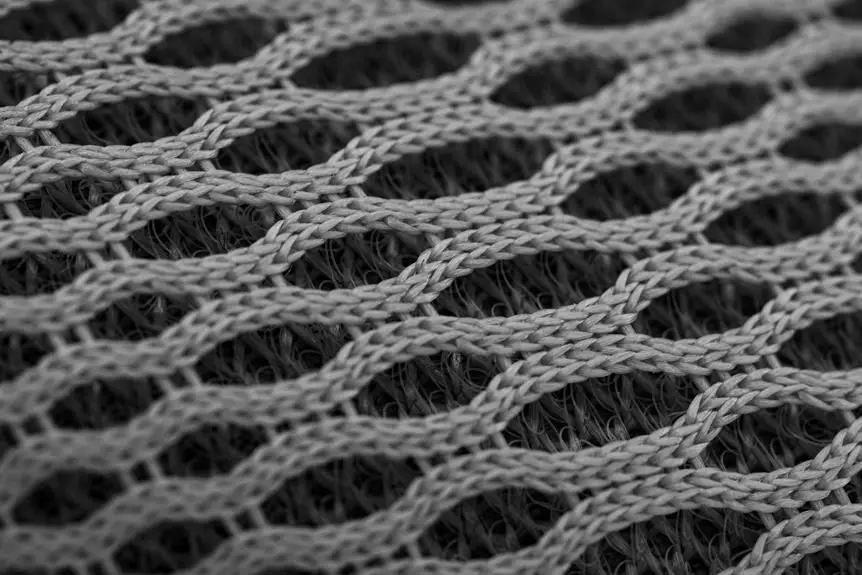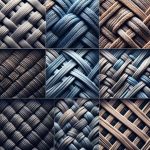When you're working with fabrics, fraying can be a real nuisance that compromises your projects. You might think it's just a minor issue, but preventing it can greatly enhance the longevity of your fabric. Start by choosing the right materials and employing proper cutting techniques, but there's more to it than that. With a few simple tips and tricks, you can keep your fabrics looking pristine and professional. Curious about how to effectively apply these methods? Let's explore some strategies that can make a significant difference.
Table of Contents
Key Takeaways
- Choose tightly woven or synthetic fabrics to reduce the likelihood of fraying.
- Use quality cutting tools like fabric scissors or rotary cutters for precise cuts.
- Employ stitching techniques such as zigzag or overlock to secure edges effectively.
- Regularly inspect and follow proper washing and drying guidelines to minimize wear.
Understanding Fabric Fraying
Fabric fraying occurs when the threads of a fabric begin to unravel, often due to wear, tear, or inadequate finishing techniques. When you use fabric frequently, like in clothing or home textiles, the edges can suffer from friction and stress, leading to those annoying little strands. Understanding how fraying happens helps you take steps to prevent it.
Different types of fabrics fray at different rates. For example, woven materials are more prone to fraying compared to knits. If you're working with fabrics that have a loose weave, you'll notice fraying more quickly as the threads are less secure. Additionally, the quality of the fabric plays a vital role; low-quality materials tend to fray more easily because of inadequate weaving techniques.
Another factor to consider is how you treat your fabric. If you wash, dry, or iron it aggressively, you're increasing the chances of fraying. Even the way you cut your fabric can affect its longevity. By being aware of these factors, you can better prepare yourself to choose appropriate handling methods that'll keep your fabric looking fresh and intact for longer.
Choosing the Right Fabric
Selecting the right type of fabric can significantly reduce the risk of fraying and extend the life of your projects. When you choose a fabric that's less prone to fraying, you're setting yourself up for success. Here are some tips to help you make the best choice:
- Opt for tightly woven fabrics: Fabrics like denim or canvas have a dense weave, making them less likely to fray compared to loosely woven materials.
- Consider synthetic blends: Fabrics like polyester or nylon often resist fraying better than natural fibers. They maintain their shape and structure, even after multiple washes.
- Choose finished edges: Look for fabrics that come with finished edges or selvedges. These edges are designed to prevent fraying and save you time on finishing techniques.
- Test small samples: Before committing to a larger piece, test how the fabric behaves when cut. This will help you identify any potential fraying issues beforehand.
Using the Right Tools
To prevent fabric fraying, you need to use the right tools.
Sharp cutting tools and proper sewing techniques can make all the difference in keeping your edges intact.
Let's explore the essential tools and techniques you should have in your sewing arsenal.
Essential Cutting Tools
Using the right cutting tools can significantly reduce the chances of fabric fraying during your projects. When you invest in quality tools, you'll notice a marked improvement in your cutting precision, which helps maintain the integrity of your fabric edges.
Here are some essential cutting tools you should consider:
- Fabric Scissors: These are specially designed to cut fabric cleanly without causing damage. Always keep them sharp for the best results.
- Rotary Cutter: Perfect for cutting multiple layers of fabric, a rotary cutter provides a smooth, even cut that minimizes fraying.
- Cutting Mat: Using a self-healing cutting mat protects your surfaces and prolongs the life of your blades, ensuring that you get the cleanest cuts possible.
- Pinking Shears: These zigzag scissors create a decorative edge that helps to reduce fraying significantly. They're great for finishing raw edges on woven fabrics.
Proper Sewing Techniques
Employing proper sewing techniques is crucial for achieving clean seams that prevent fabric fraying and enhance the overall durability of your projects.
First, make sure you're using the right needle for your fabric type. A sharp needle works best for woven fabrics, while a ballpoint needle is ideal for knits. Using the wrong needle can cause unwanted damage and fraying.
Next, choose a suitable thread. Polyester threads are strong and less likely to break compared to cotton threads, which can weaken seams over time. When you sew, maintain an even tension on your thread to prevent puckering, which can lead to fraying.
Additionally, always use the appropriate stitch type for your project. For most fabrics, a straight stitch provides a strong seam, while a zigzag stitch can help secure edges and prevent fraying.
Stitching Techniques to Prevent Fraying
One effective way to prevent fabric fraying is by incorporating specialized stitching techniques into your sewing projects. These methods not only add durability but also enhance the overall finish of your seams.
Here are four key techniques you can use:
- Zigzag Stitch: This stitch creates a wave-like pattern along the edge of the fabric, effectively securing the fibers in place and preventing fraying.
- Overlock Stitch: If you have an overlock machine, this stitch is fantastic for finishing edges. It trims the fabric while enclosing the raw edges in one go, providing a neat finish.
- French Seam: This technique encloses the raw edges within a second seam, making it ideal for lightweight fabrics. It offers a clean look and prevents fraying beautifully.
- Bias Tape: By applying bias tape along the raw edges, you not only prevent fraying but also add a decorative element to your project. It's especially useful for curves and corners.
Incorporating these stitching techniques into your sewing will help you maintain the integrity of your fabrics while achieving a polished look.
Applying Edge Finishes
When it comes to preventing fraying, applying edge finishes is essential.
You'll find various types of finishes, and each requires specific tools and a clear step-by-step process.
Let's explore these points to help you achieve neat and durable fabric edges.
Types of Edge Finishes
You can choose from several effective edge finishes to prevent fabric fraying, each offering unique benefits for your projects. Understanding these finishes will help you select the right one for your specific needs.
- Zigzag Stitch: This is a simple and quick method that creates a zigzag pattern along the edge, effectively preventing fraying while maintaining some stretch in the fabric.
- Overlock Stitch: Using an overlock machine, this stitch simultaneously trims and finishes the edge. It's ideal for knit fabrics and provides a professional look.
- Bias Tape: Wrapping the raw edge with bias tape not only prevents fraying but also adds a decorative touch. It's great for curved edges and thicker fabrics.
- French Seam: This technique encases the raw edges within a double seam. It's perfect for lightweight fabrics, providing a clean finish that's both strong and neat.
Tools Required for Finishing
To effectively apply edge finishes and prevent fabric fraying, you'll need a few essential tools that make the process smoother and more efficient.
First, a good pair of fabric scissors is crucial. They'll help you cut your fabric cleanly, ensuring you start with a neat edge. Next, consider using a rotary cutter and cutting mat for more precise cuts, especially on larger pieces.
You'll also want a sewing machine with a zigzag stitch or an overlock machine if you plan on finishing edges frequently. These machines allow you to create durable and professional-looking finishes. Don't forget to have quality thread that matches your fabric; this ensures your finishes look seamless.
For hand-sewing finishes, a needle and thread are essential, so keep a variety of needles on hand for different fabric types. You might also find fabric pins or clips handy for holding your edges in place while you work.
Lastly, a ruler or measuring tape will help you mark your fabric accurately, ensuring consistent edge finishes every time. With these tools, you'll be well-equipped to tackle any edge finishing project and keep your fabrics looking great.
Step-by-Step Application Process
Starting with a cleanly cut edge, follow these steps to effectively apply edge finishes and prevent fabric fraying. It's essential to take your time with each step for the best results.
Choose Your Finish: Decide whether you want to use a zigzag stitch, overlock, bias tape, or pinking shears. Each method has its benefits depending on the fabric type.
Prepare Your Sewing Machine: If you're using a zigzag stitch or overlock, adjust your machine settings accordingly. Make sure the needle is appropriate for your fabric.
Apply the Edge Finish: Starting at one end, guide the fabric under the presser foot. Keep a steady pace and ensure the stitching covers the edge completely. If using bias tape, pin it in place before sewing.
Secure the Ends: Once you finish stitching, backstitch at the beginning and end to secure the threads. Trim any excess fabric or thread to avoid future fraying.
Care and Maintenance Tips
Regularly inspecting fabric for signs of wear can help catch fraying before it becomes a bigger issue. Make it a habit to check seams, edges, and high-friction areas, especially on garments and home textiles that see frequent use. If you spot any loose threads, trim them promptly to prevent further unraveling.
When washing your fabrics, always follow the care label instructions. Use gentle cycles and cold water whenever possible, as hot water and harsh detergents can weaken fibers. Avoid overloading your washing machine, which can cause fabrics to rub against each other, leading to fraying.
Dry your fabrics carefully, too. Opt for air drying whenever you can, as tumble drying can cause excessive friction and heat damage. If you must use a dryer, choose a low heat setting.
Store your fabrics properly to maintain their integrity. Keep them in a cool, dry place, and avoid folding them in ways that create creases or stress points. Lastly, consider using fabric protectors or sprays designed to strengthen fibers and reduce fraying, giving your textiles a longer life.
Repairing Frayed Edges
Repairing frayed edges can breathe new life into your favorite textiles and prevent further damage. Whether it's your favorite shirt, a cherished tablecloth, or a family heirloom, taking the time to fix frays can extend the life of your fabrics.
Here are some effective methods you can try:
- Sewing: Use a needle and thread to stitch the frayed edges together. Choose a thread that matches your fabric to make the repair less noticeable.
- Fray Check: Apply a fray check solution to the edges. This liquid adhesive prevents further fraying and dries clear, making it ideal for delicate fabrics.
- Heat Seal: For synthetic fabrics, you can use a heat sealing method. Carefully run a lighter or a soldering iron along the frayed edge to melt the fibers together, but be cautious not to burn the fabric.
- Bias Tape: Attach bias tape along the edges. This not only covers the frayed area but also adds a decorative touch.
Frequently Asked Questions
What Causes Fabric Fraying in Different Materials?
Fabric fraying happens when fibers loosen due to wear, washing, or cutting. Different materials, like cotton or silk, have varying levels of durability, causing them to fray differently based on their weave and finishing processes.
Can Fraying Be Prevented With Fabric Softeners?
You might think fabric softeners can help prevent fraying, but they mainly soften fibers. Instead, consider proper washing techniques and using a serger or zigzag stitch to effectively minimize fraying on your fabrics.
How Do Environmental Factors Affect Fabric Fraying?
Environmental factors like humidity, temperature, and sunlight exposure can significantly impact fabric fraying. You'll notice that high humidity can weaken fibers, while intense sunlight can degrade materials, making them more prone to fraying over time.
Are There Specific Dyes That Reduce Fraying?
Certain dyes can help reduce fraying by strengthening the fabric fibers during the dyeing process. When you choose high-quality, colorfast dyes specifically designed for your fabric type, you enhance durability and minimize wear over time.
Is Fraying More Common in Natural or Synthetic Fabrics?
Fraying's more common in natural fabrics like cotton and linen due to their loose fibers. Synthetic fabrics, such as polyester and nylon, generally resist fraying better because of their tighter weave and durability.






